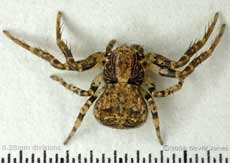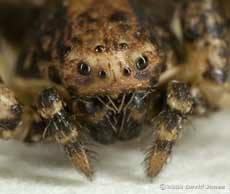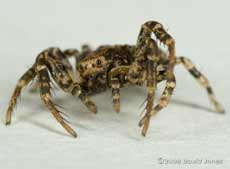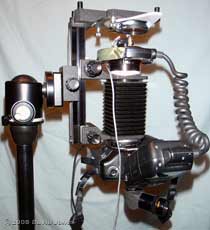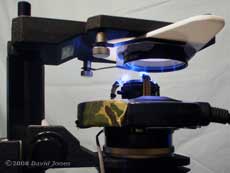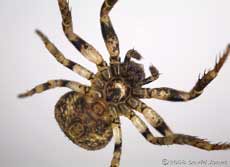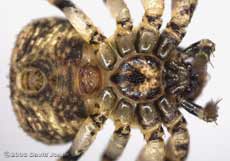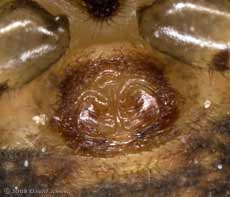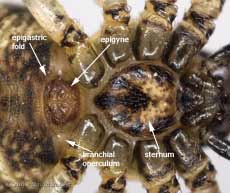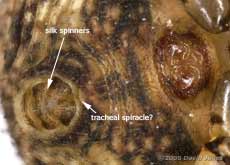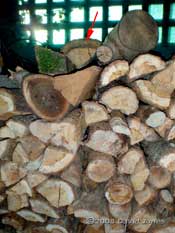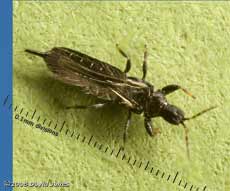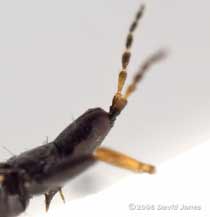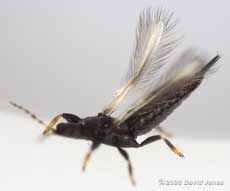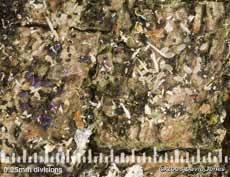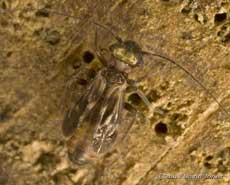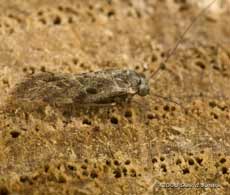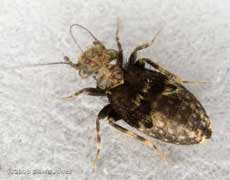Go to the last entry on this page .....Go to previous entry1 December - A bright, sunny start to the month, although it stayed cold all day with the temperature only just getting over 3C. I took advantage of the pleasant conditions to move some of our logs about before a new supply is delivered later in the week. While I was brandishing an axe a Sparrowhawk flew right over me, did a complete orbit of the Hawthorn without attempting to catch any of the Sparrows that were sheltering in there and flew off again. That is the first time I've seen one here for a while. Fortunately, my presence meant that the Goldfinches and other small birds were not around the feeders when it pounced. The cold conditions meant that there were very few barkflies to be seen on the top of the log pile during the day. Tonight, at 10pm, and with the temperature still just over 3C there are only around 20 barkflies visible on the log I'm monitoring.
The manner of its movement and its posturing suggested that it is one of the crab spiders, and a search through my spider guide leads me to think that it is a female Ozyptila praticola. This is a common species in the south of England where it is found in moss, undergrowth, hedgerows and under the bark of coniferous trees.
While most spiders have eight eyes, this is one of those that have just six (as far as I can tell!). Also, notice the blunt, club-shaped hairs. These are characteristic of this genus (Ozyptila).
A crab spiders does not build webs but instead uses its front legs to grab prey that approaches within their grasp. This species has some formidable spines on those front legs which must help to grip the victim. The insect dies very quickly once bitten and injected with venom.
While the guide talks about the crab spiders of this genus as slow moving, this individual can move quickly, although when disturbed it will stop and either take up a defensive posture, or gather its legs in close to its body. A couple of times it fell a couple of centimetres. when this happened it folded its legs right in as if feigning death, only drawing its legs out again very slowly after a long pause. Tomorrow morning I hope to take a few more pictures before I release the spider back into the log pile.
2 December - A frosty start but the temperature got up to 5C in the early afternoon. At approaching 8pm it is back down to 2C.
As suggested last night I spent time organising an arrangement to photograph the crab spider from below. The spider was free to move about in the gap between two lens filters, These were mounted on a piece of white Perspex using blue-tac today, but I will be making a permanent arrangement. This is clipped into place on the macro stage (at the top of the photograph).
For the closer photographs I used a Canon macrophoto lens with LEDs mounted around it as a focusing aid, although the ring flash provided the light for the actual photography.
Anyway, once set up there was a game of patience as I waited for the spider to wander into a suitable spot.
The main reason for taking these photographs was to confirm the identification of the spider. Just behind the hind legs of female spiders, is the epigyne, the genital opening. The epigyne is the most important structure used to identify the species, and has a reddish colouring in this individual. It measures just over 0.5mm across.
In this case it would appear to confirm that the spider is indeed Ozyptila praticola.
In addition to that information, the photographs also show a couple more interesting structures. Just behind the epigyne is the epigastric fold. To the sides of the epigyne, and in front of the fold are a pair of branchial opercula (an operculum is a lid or cover). At the back of each operculum is a slit which leads into book lungs (so called because they consist of stacked, thin, blood-filled layers of tissue).
I'm not sure if I have labelled the tracheal spiracle correctly in this picture, but it is a small fold in the correct place!
The spinnerets do not seem very well developed on this spider. However, while she does not use silk to catch prey, she will produce a papery silk to create her egg sac. She obviously does not produce s silk 'safety line as she moves about - after I released her I could find no sign of silk on the glass of the filters. The spider is now back in the log pile! Not to forget the barkflies - I've just checked the log pile at just after 10pm, and with the temperature down to 2C there are still some two dozen E. pilipennis out and about on 'their' log.
5 December - A bright, if cold start (just over 3C at 10am) this morning and hopefully a fine day. The 3rd saw temperatures not get above 2C all day after it dipped to -1C overnight - I'm afraid that I missed the frostly scene that accompanied dawn! Yesterday was milder, with temperatures over 6C, but we had some showers, with a period of heavy rain before breakfast. The freezing conditions on the night before last meant that there were no barkflies visible on the logs. However, with a temperature of 4C when I looked at 10pm last night there were once again a couple of dozen individuals moving about. This morning at 10am, and with the temperature at 4C there are none to be seen on top of the log.
Although the wood in this picture is seasoned, nearly all the timber out of shot to the left is fresh, unseasoned oak. I'm hoping that the barkflies will gradual migrate to that, as that wood will remain undisturbed until at least this time next year. The timber that you see is in fact the rear stack of logs - the front stack having already been consigned to the fire. I'm hoping that in the near future I will be getting more unseasoned timber to replace the seasoned timber that remains. A delivery of seasoned wood that should have happened late yesterday afternoon but failed to materialise should occur instead by lunchtime today. Hopefully that will give me a chance to check some of the logs for new garden visitors before the sun sets. An evening update - The logs arrived on schedule and I spent some time searching for barkflies etc. The presence of droppings suggested that I should find plenty of barkflies, but I came across only a few. I guess that by the time the logs are cut, thrown onto and then back off a vehicle, much of the insect life will have been shaken off. I'll be checking the logs again before they are burned.
One interesting insect did turn up today - a thrip. Thrips are very common insects but I cannot recall knowingly seeing one here before. I believe that this one is Phlaeothrips annulipes, a species that is found on dead birch twigs and branches where it feeds on fugal threads and spores. There were a few birch logs in today's delivery.
One of my insect guides states that thrips have small (but prominent) eyes, but I would describe these as relatively large. In addition, there are three ocelli (simple light sensors) between the compound eyes. You may be able to just make them out in these pictures.
In common with most thrips, this species has wings that are very narrow and fringed with long bristles. Despite these delicate wings, thrips are good fliers.
I'm keeping the thrip in captivity until tomorrow when (time permitting) I will try to get some sharper images. Tonight it was too active for me to keep up with! Tonight at 10.30pm it is still 5C outside and I've just checked the log pile. That one degree rise form this time last night has encouraged more barkflies out and there must be 50+ active on top of the log.
The second group is almost white in colour, with just a touch of iridescence. However, with the two groups only millimetres apart I wonder if the pale eggs are freshly laid. I shall check them again tomorrow to see if they darken in colour.
Some of the pale eggs are damaged, possibly because both groups are on an exposed surface. In the picture you can see how splinters of wood produced by a chainsaw have been caught up on the protective silk canopy.
7 December - A bright day starting with a frost that stayed on north-sloping roofs more or less all day. I don't think the temperature got up much past 2C in the shaded parts of the garden, but despite that I could see up to 12 Barkflies active on their log during the day. However, at 6pm, with the temperature in the log pile down to 1C I could only see three individuals. An hour later, with the outside air temperature down to 0C (the log pile still registering 1C) there are now five wandering over the top of the log! By 10.30pm the temperature had dropped another degree, but despite the sensor in the log pile now registering 0C there were still five barkflies moving about.
11 December - The weather has stayed dry since the last entry, and while the temperature hasn't got above 6C, it only dipped below freezing for a short time in the early hours of yesterday.
Over the last few nights I've noticed that they are not all congregated on the one log, but are now spreading out over adjacent timber.
Also, a few other barkflies have been making an appearance near the top of the pile of unseasoned logs. So far I have seen three examples of either Ectopsocus briggsi or Ectopsocus petersi (I need to take a closer look), and this single Loensia variegata.
Aside from checking on the log pile barkflies, I continue to check the 'new' logs that are heading for the fire. While I've only come across a few barkflies, I've also found several more more small clusters of the purple eggs. That reminds me, the first of these eggs that I reported back on 20 October are still intact.
13 December - Having commented about the dry, cold weather at the beginning of the last entry, yesterday saw the temperature rise from a low of almost -3C before dawn to +7C by the end of the afternoon as the weather turned damp. Subsequently, the temperature remained above 6C all night as it continued to rain, accompanied by quite a strong wind. As I write this at 9.40am, it is wet and wild outside, and there are 16 Goldfinches, five House Sparrows and a single Blue Tit at the feeders - the rain continued for the rest of the day, although the wind dropped during the afternoon, with the temperature dropping below 5C. In the shelter of the log store, the milder conditions last night brought the barkflies out again and at 10.30pm I was able to count in excess of 100 E. pilipennis, mostly on their usual log but with increasing numbers on wood either side of it.
15 December - After that mild day on the 13th, yesterday the temperature dipped below 2C first thing in the morning before settling at just under 4C for the rest of the day, not dropping below 3.5C last night under grey skies. It remained overcast for much of today, although there was a brief period of brightness in the early afternoon (when the temperature got up to 5C before dropping again over the rest of the afternoon. During the morning I took advantage of what is at the moment an all too rare burst of energy to replenish our stock of paper brickettes ( 20 made before I ran out of newspaper pulp!). While it's not good drying weather now, ones we made back in November are largely dry, and we can put a couple at a time on top of our log burner to complete the process. Now the need to tear up another bagful of old newspapers....... A bit of a miscalculation means that our readily available seasoned log supply is running short at the moment, so I'm having to take logs from the pile on which the large population of E. pilipennis resides. Tonight I started rearranging things so that the most populated logs are disturbed as little as possible during this process. While I found myself having to transfer mainly E. pilipennis as I took logs away, I also came across two examples (1 adult, 1 nymph) of Pteroxanium kelloggi, a species I first came across here at the beginning of November.
Back in November I noted how this species is very agile. Watching the adult tonight I was surprised by its ability to accelerate rapidly and move extremely quickly over a short distance - much the quickest of all the twelve barkfly species I have recorded here so far.
This nymph (about 2.5mm long) appears to have a zig-zag pattern on its thorax that is more pronounced that seen in the pictures I took on 3rd/4th November. Both are now back on the log pile. I'll be moving more timber during the day tomorrow, so I will be on the look-out for more examples of this species.
During the Brickette making session I noticed that Great Tits and Blue Tits seemed to be having what looked like a territorial dispute in and around the Birch tree - is this the start of the long Winter build up to the next nesting season? In the past we have seen visits to the box begin at around Christmas time. This reminds me that I had intended to do some work in the box before the birds start their visits - perhaps I should get something done this week. The first job will be to clear the complex of spider webs that almost fill the area that I occupy. Once they are cleared, and the wiring is tidied up, I want to add a new front-silvered mirror to help provide a look-down capability for photographing the eggs and very young chicks. I've used a mirror in the past, but I now have a larger one which I hope to mount in a semi-permanent way. Finally, I will get one of the cameras up and running, and connected to the time-lapse recorder so that I can start monitoring the box for early visits. Click on images to see larger versions |
|
